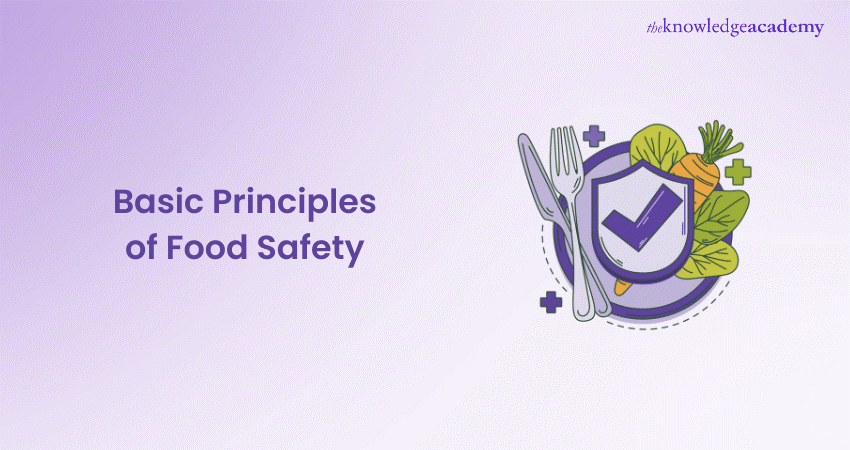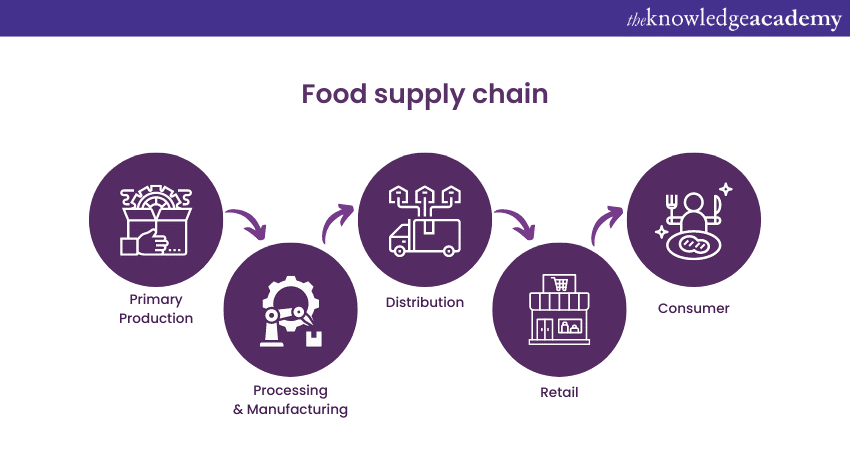We may not have the course you’re looking for. If you enquire or give us a call on +65 6929 8747 and speak to our training experts, we may still be able to help with your training requirements.
Training Outcomes Within Your Budget!
We ensure quality, budget-alignment, and timely delivery by our expert instructors.

Food Safety is an important aspect of our daily lives, ensuring that the food we consume is free from harmful pathogens, chemicals, and contaminants. This is why, professionals working in the Food and Manufacturing industry must be familiar with the Basic Principles of Food Safety. These Principles encompass a range of practices and regulations that aim to safeguard the quality and wholesomeness of food from production to consumption.
According to the World Health Organisation, on average, 1.6 million people get sick due to unsafe food every day. Thus, by learning the Basic Principles of Food Safety and following the steps of food safety, one can ensure a healthy and illness-free lifestyle. In this blog, we will learn about the basics of Food Safety Principles and delve into the key concepts of food hygiene, prevention, and challenges in Food Safety.
Table of contents
1) The importance of Food Safety
2) Basics of Food Safety Principles
a) Cleanliness and hygiene
b) Cross-contamination prevention
c) Safe food storage
d) Proper cooking and temperature control
e) Personal hygiene of food handlers
3) Emerging challenges in Food Safety
4) Conclusion
The importance of Food Safety
Food Safety is all about human health. Food contamination may cause simple discomfort or may initiate severe or even life-threatening diseases. Pathogenic microorganisms, such as bacteria, viruses, parasites, can contaminate food. These pathogenic organisms can cause gastrointestinal infections and food poisoning. Moreover, strong chemical contaminants can provoke a variety of cancers and allergies. Chemo-contamination, associated with pigments and poisonous substances, can also death.
Following Food Safety Principles is important for both personal and organisational levels. By following its principles and practices, you can ensure a healthy lifestyle, high productivity, economic impact and customer confidence.

Basics of Food Safety Principles
The basics of Food Safety Principles focus on key practices that are vital for maintaining the safety and integrity of the food we consume. These principles form a strong foundation for preventing foodborne illnesses and ensuring the well-being of individuals and communities. Understanding the benefits of food safety highlights how these principles help protect public health and enhance overall quality of life. Some of the most crucial principles are as follows:

Cleanliness and hygiene
It is essential to maintain cleanliness and hygiene to ensure Food Safety. Cleanliness helps stop harmful germs from spreading, preventing illness. This involves more than handwashing - keeping kitchens, utensils, and surfaces clean is crucial. When handling food, ensure clean hands. Avoid contact if unwell.
Use soap and water for cleaning. Scrub hands thoroughly, drying with a clean towel. Clean utensils after each use, especially when switching between food types. Keep kitchen surfaces spotless, as germs can lurk on counters and tables. Regular cleaning significantly reduces the risk of germs contaminating your food.
Cross-contamination prevention
Cross-contamination prevention is a critical aspect of food safety that involves keeping harmful germs from spreading between different foods. It's a simple yet vital practice that helps protect you and your family from foodborne illnesses.
To prevent cross-contamination, keeping raw meats, poultry, and eggs separate from ready-to-eat foods like fruits, vegetables, and cooked dishes is crucial. So, use different cutting boards and utensils for different types of foods to avoid transferring harmful bacteria. Colour-coded cutting boards can be a helpful visual aid to remember which board is for what type of food.
Washing your hands thoroughly before and after handling different types of food is a simple but good way to prevent the spread of germs. This applies to anyone handling food – whether you're a home cook or a professional chef.
Elevate your food safety expertise with our Food Allergy Awareness Masterclass!
Safe food storage
Storing food the right way keeps it fresh and safe to eat. When it comes to safe food storage, one of the key factors to consider is temperature. Different foods have different temperature requirements. Refrigeration is a powerful way to slow down the growth of bacteria in perishable items like raw meat, dairy products, and prepared foods. Your refrigerator should be set to 40°F (4°C) or lower to keep these foods safe.
Storing raw foods on the bottom shelf of your refrigerator will help to prevent their juices from dripping onto other foods. Use airtight containers or proper wrapping to prevent cross-contamination and to keep food fresh. Label leftovers with dates so you know when to use them, and try to consume them within a reasonable time to ensure their quality.
Canned goods and non-perishable items like pasta and grains can be easily stored at room temperature in a cool, dry place. Check for any signs of damage or bulging in canned goods before using them, as this could indicate spoilage.
Proper cooking and temperature control
When cooking food, it's essential to ensure that it reaches the appropriate temperature. Various types of food require different temperatures to kill off harmful microorganisms. Using a food thermometer can be a reliable way to check if food has reached a safe temperature. For example, poultry like chicken and turkey should reach an internal temperature of a minimum of 165°F (74°C), while ground meats should be cooked to 160°F (71°C).
Equally important is maintaining the correct temperature during food storage. Perishable foods should be kept cold in the refrigerator at 40°F (4°C) or below to slow the growth of bacteria. When serving hot food, make sure it remains at 140°F (60°C) or higher to prevent bacterial growth.
Don't miss our Handpicked Food Safety Questions and Answers from our Expert team to crack Interviews Easily
Personal hygiene of food handlers
The personal hygiene of food handlers is a fundamental pillar of food safety that directly impacts the quality and safety of the meals we consume. It encompasses a range of practices that ensure the prevention of contamination, the safeguarding of public health, and the maintenance of consumer trust.
Effective hand hygiene stands as the first line of defence against the spread of harmful bacteria and pathogens. Food handlers must diligently wash their hands before touching any food, after handling raw ingredients, after using the restroom, and after any activity that might lead to contamination. Thoroughly washing hands with soap and water, followed by proper drying, significantly reduces the likelihood of transferring germs to the food.
Equally important is the requirement for food handlers to wear clean and suitable attire. Clean uniforms or aprons serve as barriers to prevent loose hair, dirt, or other contaminants from coming into contact with the food.
Emerging challenges in Food Safety
As our global food systems become increasingly complex and interconnected, new challenges in food safety have arisen that demand vigilant attention and proactive solutions. These challenges are driven by factors such as technological advancements, changing consumer preferences, and evolving production methods. Understanding and addressing these challenges are essential for the safety of the food supply and the well-being of consumers.
Register for our Food Safety Training and explore Food Safety standards to ensure culinary hygiene.
Antimicrobial resistance (AMR)
Antibiotic overuse in both human medicine and agriculture has led to the development of drug-resistant bacteria. This poses a significant threat to food safety as it reduces the effectiveness of antibiotics in treating foodborne illnesses. Contaminated food carrying antibiotic-resistant bacteria can contribute to the spread of these resistant strains, making infections harder to treat.
Globalisation of the food supply chain
As food travels across borders, the potential for contamination or adulteration increases. Monitoring and regulating a diverse array of food products and sources have become more challenging, requiring international cooperation and robust inspection systems to ensure food safety standards are met. To ensure the safety of food, it is important to restrict contamination in supply chains.

Novel food production methods
novel food production methods such as cell-based meats and genetically modified organisms (GMOs) have gained traction. While these innovations offer potential benefits like sustainability and enhanced nutritional profiles, they also raise questions about their safety, labelling, and potential long-term health effects. Ensuring the safety of these new products requires thorough scientific evaluation and regulatory oversight.
Changing consumer habits
Changing dietary habits and consumer demands also present food safety challenges. Increased demand for fresh, minimally processed foods and a growing interest in local and organic produce means that more food is being consumed in its raw or minimally cooked state. This requires heightened attention to prevent contamination during production, handling, and distribution.
Climate change impact
Climate change introduces uncertainties in food safety. Rising temperatures can create favourable conditions for the growth of pathogens, and extreme weather events can disrupt supply chains, potentially leading to food safety risks. Adaptation strategies, such as improved infrastructure and disaster preparedness, are crucial to mitigate these risks.
Conclusion
Food Safety Principles are essentially the basic and most fundamental steps towards a safe and healthy environment. We hope you liked this blog and understood the Basic Principles of Food Safety and how to improve a healthy and safe environment around you with the help of these principles. Enjoy reading!
Learn and prioritise your Food and safety standards by registering for our Food Hygiene and Safety Training!
Frequently Asked Questions

Yes, Food Safety in the industry is governed by regulations like the Food and Drug Administrations’s FSMA in the U.S., and globally by the Codex Alimentarius. Certifications like SQF, BRC, and IFS, benchmarked by the GFSI, ensure adherence to safety standards through regular audits.

To ensure safe food transportation, use temperature-controlled vehicles, regularly sanitize containers, implement strict loading/unloading procedures, adhere to proper packaging standards, and monitor and document the entire transportation process to maintain the integrity and safety of food products during transit.

The Knowledge Academy takes global learning to new heights, offering over 30,000 online courses across 490+ locations in 220 countries. This expansive reach ensures accessibility and convenience for learners worldwide.
Alongside our diverse Online Course Catalogue, encompassing 17 major categories, we go the extra mile by providing a plethora of free educational Online Resources like News updates, Blogs, videos, webinars, and interview questions. Tailoring learning experiences further, professionals can maximise value with customisable Course Bundles of TKA.

The Knowledge Academy’s Knowledge Pass, a prepaid voucher, adds another layer of flexibility, allowing course bookings over a 12-month period. Join us on a journey where education knows no bounds.

The Knowledge Academy offers various Food Hygiene and Safety Courses, including Food Safety and Hygiene Course, Food Hygiene and Safety in Manufacturing Training, and Food Allergy Awareness Training. These courses cater to different skill levels, providing comprehensive insights into Benefits of a Healthy Lifestyle and how to Sustain it?
Our Health & Safety Blogs cover a range of topics related to Food and Safety, offering valuable resources, best practices, and industry insights. Whether you are a beginner or looking to advance your Food Safety skills, The Knowledge Academy's diverse courses and informative blogs have you covered.
Upcoming Health & Safety Resources Batches & Dates
Date
 Food Safety and Hygiene Course
Food Safety and Hygiene Course
Fri 3rd Jan 2025
Fri 28th Mar 2025
Fri 23rd May 2025
Fri 4th Jul 2025
Fri 5th Sep 2025
Fri 24th Oct 2025
Fri 5th Dec 2025







 Top Rated Course
Top Rated Course


 If you wish to make any changes to your course, please
If you wish to make any changes to your course, please


